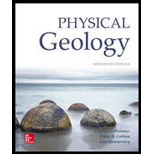
The difference between the quantity of water that would percolate downward to the saturated zone beneath a flat meadow in northern New York and a rocky hillside in southern Nevada. The factors that control the quantity of percolation in the case of flat meadow in northern New York and rocky hillside in southern Nevada.
Introduction:
The water that precipitates from the atmosphere as rain and snow infiltrates the geosphere and becomes groundwater. The movement of water in the downward direction through rocks and sediments is known as percolation. The water percolates down into the ground through the soil and through the cracks, pores, openings, fractures or voids present in the rock by the pull of gravity. The groundwater moves hundreds of meters vertically downward before rising again to discharge as a spring or seep into the beds of rivers and lakes at the surface.
Want to see the full answer?
Check out a sample textbook solution
Chapter 11 Solutions
Physical Geology
- According to Kanazawa (2023), it helps if your ____ is concrete and specific. He also suggests that, in environmental studies (as well as in geography), it also has the potential to offer some insight into environmental issues by examining some cause-and-effect relationships. Question 7 options: research question research methodology research topicarrow_forwardKanazawa (2023) describes some research on the impact of climate factors on the numbers of people visiting a state park in northern Minnesota. He argues that it’s a good example of a project that is amenable to a quantitative approach because it involves objectively measured, numerical data. That data can them be used to ____, which involves assessing your best guess about the relationship between the variables. Question 6 options: deduce the structure of cause-and-effect. see if there is a statistical correlation test a hypothesisarrow_forwardAccording to Clifford & Valentine (2003), the reason that the discipline of geography has seen its practitioners use such a wide number of methods for data collection and so many different research methodologies employed in their work is because geographers: Question 5 options: consider a very broad range of topics to be suitable for geographic research. have favoured extensive forms of research. are inclined to seek out the policy implications of many different developments.arrow_forward
- Clifford & Travis (2018) interviewed four groups of people in the south-central Colorado mountains – including 26 people in all – in order to learn ___ they constructed their climate knowledge through daily practices and engagements with the landscape around them. Question 3 options: where how whenarrow_forwardAccording to Windschitl (2023), the exchanges of carbon between the atmosphere and the terrestrial biosphere through photosynthesis, the respiration of plants and animals, and the decomposition of organic matter are all part of the: Question 1 options: slow carbon cycle. fast carbon cycle. carbon-fibre bicycle.arrow_forward6:52 PM Thu Jan 23 world.pendalearning.com My Apps Dashboard | identity-mgr Sis Grades and Attendance HOME ASSIGNMENTS WORLD V AVATAR V MORE V Weather vs Climate Differentiating Between Weather and Climate (Achieving) Penda World 42 7550 5125 Practice It! Which of the following describes a factor that affects the weather? Weather changes when the climate happens daily Precipitation changes the weather, but the temperature has little effect on the weather Temperature changes the weather, but precipitation has little effect on the weather Weather changes based on the amount of water in the atmosphere and the temperature + Screen 5/1arrow_forward
- Six in text and bibliography APA references for managing minerals as a natural resource and the challenges of itarrow_forwardIn text and bibliography APA references for managing minerals as a natural resource and the challenges of itarrow_forwardPLEASE HELP ASAP On Figure 3.8, outline the zone of earthquakes. Draw a line in Figure 3.8 at the depth of 100 kilometers to indicate the top of the asthenosphere - the zone of partly melted and weak Earth material. Label the line top of the asthenosphere.arrow_forward
- Hexagonal system. Indicate the expression that gives the volume of the “larger cell” and the volume of the “smaller cell”.arrow_forwardHexagonal system. Indicate the volume of the “larger cell” and the volume of the “smaller cell”.arrow_forwardHexagonal system. Relate the radius R to the axial lengths a and c, where a is the length of the edges of the base and c is the height of the prism.arrow_forward
 Applications and Investigations in Earth Science ...Earth ScienceISBN:9780134746241Author:Edward J. Tarbuck, Frederick K. Lutgens, Dennis G. TasaPublisher:PEARSON
Applications and Investigations in Earth Science ...Earth ScienceISBN:9780134746241Author:Edward J. Tarbuck, Frederick K. Lutgens, Dennis G. TasaPublisher:PEARSON Exercises for Weather & Climate (9th Edition)Earth ScienceISBN:9780134041360Author:Greg CarbonePublisher:PEARSON
Exercises for Weather & Climate (9th Edition)Earth ScienceISBN:9780134041360Author:Greg CarbonePublisher:PEARSON Environmental ScienceEarth ScienceISBN:9781260153125Author:William P Cunningham Prof., Mary Ann Cunningham ProfessorPublisher:McGraw-Hill Education
Environmental ScienceEarth ScienceISBN:9781260153125Author:William P Cunningham Prof., Mary Ann Cunningham ProfessorPublisher:McGraw-Hill Education Earth Science (15th Edition)Earth ScienceISBN:9780134543536Author:Edward J. Tarbuck, Frederick K. Lutgens, Dennis G. TasaPublisher:PEARSON
Earth Science (15th Edition)Earth ScienceISBN:9780134543536Author:Edward J. Tarbuck, Frederick K. Lutgens, Dennis G. TasaPublisher:PEARSON Environmental Science (MindTap Course List)Earth ScienceISBN:9781337569613Author:G. Tyler Miller, Scott SpoolmanPublisher:Cengage Learning
Environmental Science (MindTap Course List)Earth ScienceISBN:9781337569613Author:G. Tyler Miller, Scott SpoolmanPublisher:Cengage Learning Physical GeologyEarth ScienceISBN:9781259916823Author:Plummer, Charles C., CARLSON, Diane H., Hammersley, LisaPublisher:Mcgraw-hill Education,
Physical GeologyEarth ScienceISBN:9781259916823Author:Plummer, Charles C., CARLSON, Diane H., Hammersley, LisaPublisher:Mcgraw-hill Education,





